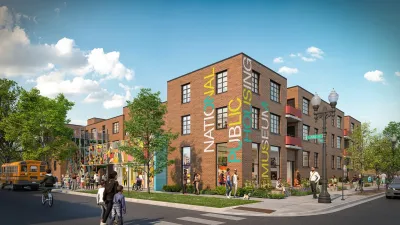MINNEAPOLIS--If not for the Walker Art Center I would have scant reason to spend extra time in Minneapolis. Minneapolis is not lacking for charm or culture, but it certainly falls in that middle range of American cities, somewhere between New York and nondescript, which is to say that it is not a destination in and of itself, yet it offers reasons to extend a stay for those who find themselves so far north for other reasons.
MINNEAPOLIS--If not for the Walker Art Center I would have scant reason to spend extra time in Minneapolis. Minneapolis is not lacking for charm or culture, but it certainly falls in that middle range of American cities, somewhere between New York and nondescript, which is to say that it is not a destination in and of itself, yet it offers reasons to extend a stay for those who find themselves so far north for other reasons.
Minneapolis derives a great deal of pride from the Walker, because of both its collection and its architecture, which comes courtesy of a relatively recent addition and redesign by Herzog and de Meuron. Without it, Minneapolis would be ever so much more stark, and I would be at a bar watching football rather than wandering galleries contemplating eternal questions. None of those questions, however, has anything to do with Minneapolis.
because of both its collection and its architecture, which comes courtesy of a relatively recent addition and redesign by Herzog and de Meuron. Without it, Minneapolis would be ever so much more stark, and I would be at a bar watching football rather than wandering galleries contemplating eternal questions. None of those questions, however, has anything to do with Minneapolis.
For an urbanist, exploring a new city means walking the streets, stopping into cafes, c hecking out distinctive neighborhoods and downtown. It means riding light rail and discerning how the city's structure reveals its local culture, and, especially in Minnesota, its local climate and environment. (Sometimes it means getting off a bus, walking down a snow-crusted street at 8p.m. on a Tuesday eating mixed nuts out of a can, and reciting to myself the wisdom of the city's favorite son: "It's all in the experience.") Most of all, it means seeking out those features of landscape and local culture that differentiate it from anywhere else. No mean feat in Dick Cheney's America.
hecking out distinctive neighborhoods and downtown. It means riding light rail and discerning how the city's structure reveals its local culture, and, especially in Minnesota, its local climate and environment. (Sometimes it means getting off a bus, walking down a snow-crusted street at 8p.m. on a Tuesday eating mixed nuts out of a can, and reciting to myself the wisdom of the city's favorite son: "It's all in the experience.") Most of all, it means seeking out those features of landscape and local culture that differentiate it from anywhere else. No mean feat in Dick Cheney's America.
Though Minneapolis derives a considerable degree of its civic identity from the Walker – like many other cities and their own museums – I am hard pressed to discern a connection between the institution and the city beyond the coincidence of its presence in the city. I have my problems with its setting: standoffish in a park just off the shoulder of downtown. Its odd angles rise out of the snowfields in a perfectly pleasing manner. There is, however, nothing about the Walker that could not translate suitably to any other American city. Swap it for the Kimbell, L.A .'s MOCA, the Denver Art Museum, or even the Guggenheim Bilbao, and things would be pretty much the same (except I'd be dead, because I'd sooner impale myself on one of Daniel Libeskind's spires than find meaning in them). If only museums could loan themselves out to each other.
In a city known for Lutheran charm and its own species of nice, the Walker is neither home-grown nor nice. It's not nice in the sense that contemporary art rarely has anything nice to say, though I don't think nihilism and hopelessness has rubbed off too much on the folks here. It's not home-grown in the sense that it has nothing to do with the indigenous culture of the city. All art, it would seem, has been plundered.
Quite the opposite is true of the Mill City Museum, which rises from the banks of the Mississippi like a ruin from an antique civilization. Minneapolis rose to prominence for reasons derived directly from geography and landscape: it lay amid the great grain fields of the Northern Plains, drew power from the fledgling Mississippi River, and sent its products down the same. In few places has industry and agriculture intersected so profoundly, with 26 mills at its peak churning out a breathtaking portion of the world's refined grain. This is why people brave the arrowheads of winter in America's icebox. The men and women who worked in the mills – roughnecks, immigrants, and Lutherans alike – were the bedrock of Minneapolis's vernacular culture, literally home-grown. They would likely be surprise to find out that the hot, explosive sentinels in which they toiled are not merely gone but instead teaching second-graders the wonders of hydropower.
which rises from the banks of the Mississippi like a ruin from an antique civilization. Minneapolis rose to prominence for reasons derived directly from geography and landscape: it lay amid the great grain fields of the Northern Plains, drew power from the fledgling Mississippi River, and sent its products down the same. In few places has industry and agriculture intersected so profoundly, with 26 mills at its peak churning out a breathtaking portion of the world's refined grain. This is why people brave the arrowheads of winter in America's icebox. The men and women who worked in the mills – roughnecks, immigrants, and Lutherans alike – were the bedrock of Minneapolis's vernacular culture, literally home-grown. They would likely be surprise to find out that the hot, explosive sentinels in which they toiled are not merely gone but instead teaching second-graders the wonders of hydropower.
The Mill City Museum's galleries display the artifacts of industry; they are captivating if not beautiful. Their meaning is as explicit as anything: Here men toiled. We salute their efforts and thank them for the city that arose on their backs.
By contrast, the Walker's collection – a broad array of Warhols and Rothkos and Klines and all the rest – is no more at home here than are the treasures of Pergamon in Berlin or the Elgin Marbles in London. Each has been plundered to the delight of alien populations. And each has been run up the flagpole to aggrandize their respective cities, build cultural currency, and attract discerning visitors.
But, while historical art may have been pried from walls and carried off under the barrel of a tank, high art is always about displacement. Anything that serious transcends place. High art is placeless and therefore has every reason to pop up wherever collectors see fit. Cities, of course, have seized upon this cultural liquidity to build institutions and amass collections in order to have their fair share of global cultural currency.
The works in the Walker have not been plundered from tribal homelands or the vaults of nations. They have been bought with hard cash, earned locally. American culture is commerce, and commerce has always been the most crucial catalyst in the creation of high art. So the pieces have been purchased and shipped out, and the Swiss architects hired and paid a fair price for them to contemplate a site and bestow their genius on the natives. The collection links Minneapolis with – not distinguishes it from – Ft. Worth and Denver and New York and Berlin and Paris itself. Their museums are like the tips of great fiber-optic filaments, rising to the globe's surface, shining the light of cosmopolitanism.
Unlike a library, which promulgates works that were meant to be promulgated, museums contain unique originals, and the museum as place is far more important than library as place. In a library, we borrow books that are meant to be reproduced. Art is unique and eternal; therefore, the museum borrows us.
Ultimately, the Walker doesn't reflect anything about Minneapolis, except perhaps money and ambition, but ambition of the best kind. Its true value is far more active: it does not contain Minneapolis's culture; it creates it. The Walker creates a cultured Minneapolis in the same way that the YWCA creates a fit Minneapolis. The only formal difference is that the Walker's contents cannot be copied; whatever it displays, it denies to the rest of the world. It offers a forum for locals to come together, view, contemplate, discuss, and enjoy. For the tourist or the wayward attendee of the podiatry convention, none of this matters beyond a few hours of time well spent. But for the locals, it means everything. It means as much today as those mills did 80 years ago, when agro-industrial prosperity laid the groundwork for a crucial frivolities like art.
Since the Walker opened, the critical mass of locals who have visited the galleries, had images fused in their minds, and return to the restaurants, bars, and living rooms to find others who have seen the same things and no doubt formed radically different thoughts. The real Minneapolis takes place in those conversations: the space between one interpretation and another. That conversation is public, original, and, most importantly, indigenous.

Planetizen Federal Action Tracker
A weekly monitor of how Trump’s orders and actions are impacting planners and planning in America.

Maui's Vacation Rental Debate Turns Ugly
Verbal attacks, misinformation campaigns and fistfights plague a high-stakes debate to convert thousands of vacation rentals into long-term housing.

Restaurant Patios Were a Pandemic Win — Why Were They so Hard to Keep?
Social distancing requirements and changes in travel patterns prompted cities to pilot new uses for street and sidewalk space. Then it got complicated.

In California Battle of Housing vs. Environment, Housing Just Won
A new state law significantly limits the power of CEQA, an environmental review law that served as a powerful tool for blocking new development.

Boulder Eliminates Parking Minimums Citywide
Officials estimate the cost of building a single underground parking space at up to $100,000.

Orange County, Florida Adopts Largest US “Sprawl Repair” Code
The ‘Orange Code’ seeks to rectify decades of sprawl-inducing, car-oriented development.
Urban Design for Planners 1: Software Tools
This six-course series explores essential urban design concepts using open source software and equips planners with the tools they need to participate fully in the urban design process.
Planning for Universal Design
Learn the tools for implementing Universal Design in planning regulations.
Heyer Gruel & Associates PA
JM Goldson LLC
Custer County Colorado
City of Camden Redevelopment Agency
City of Astoria
Transportation Research & Education Center (TREC) at Portland State University
Jefferson Parish Government
Camden Redevelopment Agency
City of Claremont





























